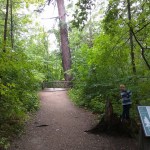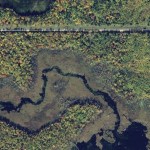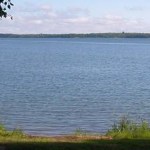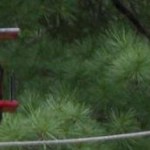Notes from the North Country
When I studied the Efe Pygmies of the Congo, I discovered (and yes, it was me who discovered this amazing fact everyone now knows) that the Efe organize their space in elongated linear trails. They knew all about everything along those specific trails, and their knowledge of other trails was often very limited. If an Efe person spent time living with a group associated with a trail, he* would learn about that trail as well. Most interesting is that one’s knowledge of important things like where to find food (or danger) was based on experience not on general principles. So an Efe off his trail…
In Minnesota’s Lakes Country, what we sometimes call “Up North,” the people have various degrees of knowledge of the land and its wildlife. Cabin people and campers visit briefly and may learn in detail the workings of a particular lake or patch of forest, but are usually poorly informed of the true nature of the landscape. People with “lake homes” (seasonally used cabins on steroids owned by people who live elsewhere) may spend more time in Lakes Country but actually know less about it than campers might because having central heating and air conditioning, a paved driveway, and big-ass SUV…
When installing a "porch light" (to light the entrance way ans any stairs, and the immediate area outside the cabin) do not place the light near the door as is often the custom. The light is meant to be used at night. Out in cabin country, when you turn that light on at night, 22 gazillion insects will flock to it and form a giant swarm covering a blob shaped area several feet in diameter. If the light is placed next to the entrance door, this makes that door unusable unless you wish to admit about half of the insects (about 10 gazillion of them) into the cabin.
Instead, place the outdoor…
Despite the fact that we observe the world around us everyday, for many common phenomena we have a very poorly developed sense of the important variables of size, shape, position, and motion. As I sit here by the side of the lake and look around numerous examples come to mind. One example arises from a (somewhat) rare phenomenon I'm seeing right now. I'm looking north at a lake. To my right, east, is a cloud looming over the rising sun. The cloud is bight white and the contrast between the top of the cloud and the blue sky above it is sharp, and I can see structure to the cloud ...…
Tip 1: Get some corn-on-the-cob and a large pot for which you have a tight fitting top. Husk the corn while you boil a large amount of water in the pot (salted if you like, for flavor). Put the corn-on-the-cob in the water and leave the heat on only for a minute, put the top on and turn off the heat. Since there is no more boiling the corn will not likely overcook. In ten minutes or so it will be ready, but it will sit there in the hot water for a long time (did you remember to keep the to on?) as long as you keep the top on.
Variation: If you have a smallish pot, microwave the corn for a…
A new multi-part special, Wild Mississippi will be first aired on February 12 at 6 Central on National Geographic Wild. I can't watch this when it is on because I don't get the channel on my TV, but I copped a review copy and have enjoyed it quite a bit.
Here's the description of the first episode:
Nat Geo WILD travels to the starting point of the mighty Mississippi River -- Lake Itasca in Minnesota, where the 2,350-mile journey to the Gulf of Mexico begins. Harsh cannot begin to describe the winter in this region, where temperatures reach 33° below zero. Survival strategies are as…
This post at 10,000 Birds, an item I accidentally bumped into on the Internet while looking for something else, and an unusual sighting moments ago, converge. And, its a nice distracting convergence which I need right now because as I sit here one week before fishing opener, looking at the glassy surface of Hunters Bay, I see fish jumping everywhere. Not only that, but a 54 inch muskie was found dead a few days ago 25 feet from where I'm sitting now. And, the Department of Natural Resources put up a fish weir just across the bay, and they've been coming by every morning and pulling out…
Over the last few days, there have been several reports of mass die-offs of birds, and one report of a fish die-off. These events have been linked, via suggestion but not evidence, to hail, lightning, fireworks, aircraft, aliens, each other, poison gases, and even pockets of oxygen free air. Many have suggested that there may be a cover up. What is the explanation for so many highly unlikely events happening in such a short time period?
The answer may astound you:
Nothing.
According to available records, close to a hundred mass die-offs of birds occur each year in the US. The recent…
The following is a fictionalized version of a true story recently told to me by two of the people involved. All the names of those still living have been changed. Please do not let this happen to you.
~~~~~
No one is sure why Fred took the chance he took that day, but when Elmer saw him flailing in the icy water surrounded by black ice 300 yards out in Medicine Lake, he did not at that time think to divine his motivations for being there. Fred, an old man who had been ice fishing for dozens of generations of fish and two or three generations of more mortal men, had gone out on the black…
Two weeks ago Julia and I took the road from the cabin to Longville and back and noticed that they had put up a new sign at each end of the curvy, hilly treacherous part, where you drive dangerously high above bogs and wooded kettles with no guard rail and there is one blind curve after another. Of treacherous roads I've been on, I'd say this bit of rural highway ranks about ... 10 thousandth, but I've driven thousands of kilometers in the Congo, so the comparison is not really fair. Anyway, the signs are large like the kind that might announce the entrance to a national forest or the…
This weekend was Deer Opener in Minnesota. So the traffic going up to the cabin resembled Fishing Opener, and the entire experience was like Fishing Opener, but with more blasting and less splashing. Also, we didn't see a single deer all weekend, and other critters were acting strangely. Something spent part of the weekend living under the porch and driving the dogs nuts, for instance.
We heard when we arrived late Friday Night that a hunter saw a timber wolf (and the timber wolf saw him) while the hunter tried out his deer stand earlier this week. The folks who own the hardware store…
Every now and then I hear a sound like a bird hitting the window. Half the time I can also hear the other parts of the noise a shotgun makes, but half the time it sounds just like a bird hitting the window and nothing else. Then, off in the distance I see between five and fifteen or so ducks flying fast across the bay from the general direction of wetlands.
Last week as we drove south on Rt. 371 near Nisswa, Amanda and I saw a bird that we both knew was a golden eagle the moment we saw it. I said "So, what was that?," handing her the bird book that I keep in the driver's side door pocket.…
I've heard of "carrion beetles" but this is more like a "carry-on beetle":
Amanda and I were outside the cabin in Cass County, Minnesota last week, cutting pieces of plywood for sub flooring, and we saw this creature among the debris. At first I thought it was some kind of wasp covered with tiny spiders, but on further investigation it turned out to be a beetle covered with mites. When we first saw it, there were many more mites than in this photo, and they were virtually roiling on the insect's surface. It looked almost as though the insect was foaming.
We captured it for later…
Replacing floors is a total exercise routine. Moving furniture out of the way, ripping up whatever is there, measuring and cutting new sub flooring, carting around heavy sheets of plywood, tacking and nailing, and so on and so forth works every single muscle in one's body. That's what we did last weekend. Also, I was able to demonstrate my special technique for testing if a particular floor is safe, or if it is so rotted out that it has to be replaced; You stand on it bouncing up and down a little bit and if you crash through to the basement, that part of the floor was bad.
Saw the…
In our recent tour of the northern and western parts of Minnesota, we stopped briefly at Tamarack Wildlife Refuge. Here are a few shots:
Although this diorama is at Tamarack, it is really a story more germane to Itasca. Shown here is the ongoing struggle for existence, etc. etc., between the fisher and the porcupine. This is one of those interesting ecological stories reminiscent of the cats/bees/cows/milk story of Darwin. It goes like this:
Porcupines eat pine trees.
Fishers eat porcupines (and nothing else really does)
Humans love their pine trees (to cut down and sell the wood).…
As you know, we just spent a few days at Itasca (see this for the meaning of the word "Itasca") where we saw some interesting wildlife. I thought I 'd share a few photos of the trip.
We were at Itasca because Amanda volunteered to help out with the orientation for new biology grad students, by giving a demonstration of what she does in the Dave Thomas lab. I did not see the demonstration but I think it had something to do with reanimating tissues. Here's a photograph of the entrance way to the research station, which is all most people can see because you are not allowed in there. (…
There is a swath across the map of Minnesota that runs northwest to southeast across the state, separating the major biomes of the eastern two thirds of the country, and for complicated reasons. North, it is colder, south warmer. Much of the moister in the region, especially in the summer, comes from the Gulf of Mexico, directly to the south, whence air masses move north and swerve east. So, there is a west to east gradient of increased rainfall, and a south to north gradient of decreased rainfall. However, the cooler conditions to the north mean that what rain does fall counts for more,…
Amanda next to the tallest white pine tree in Minnesota
They say Lake Itasca is the source of the Mississippi. This is why there is a big state park surrounding the lake, a park that preserves some beautiful old forest despite the best efforts of 19th century lumberjacks to cut it down.
I've been to Itasca a number of times, and I've even done archaeological research there (which didn't turn out to be very interesting). But when I went to Itasca last week, it was my first visit with no work agenda, and I got to spend more time poking around and seeing the sights. I was visiting because…
When I was a kid, I spent a lot of time at lakes, but the idea of walking around a lake hardly every occurred to me or anyone else. This might be because the lakes were either really big (like the Great Sacandaga Reservoir) or nestled into deep sided rock canyons carved out by glaciers, and thus, not walk-aroundable. Lakes were central places, termini of inland pathways, points along long distance hikes, not things you walked around.
Eventually, I moved to Minnesota where there are probably between five and ten thousand lakes that a) are about the right size to walk around in several…
To answer that question briefly, it is really really old if you mean "how old are the oldest rocks that are exposed by the Grand Canyon," and it is probably just a few million years old (5 or 6 by some estimates) if you mean "how long did the canyon itself take to form."
An African peneplain elevated by doming along the Eastern Rift Valley. The original surface, once flat but now raised as "mountains" in the distance, is shown by the dotted line.
A repost
But Creationists, of course, have a different story, especially young earth creationists. I'm not going to recount it here. If you want to…




